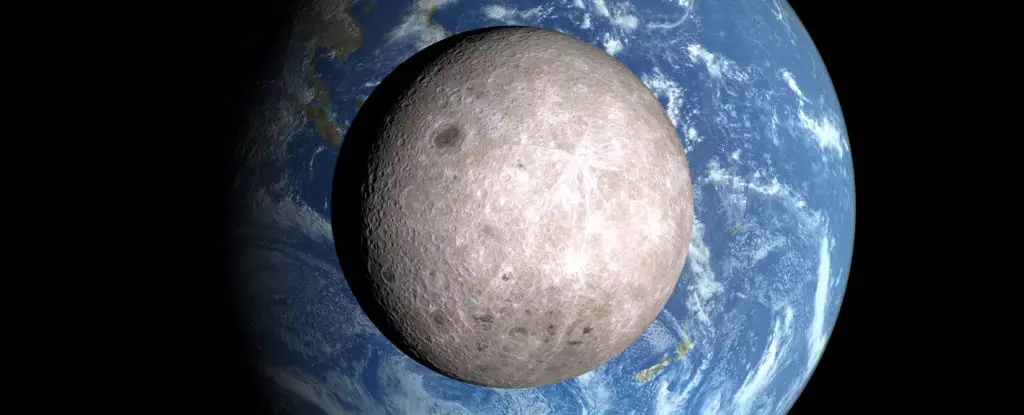The Moon, our closest cosmic companion, has long fascinated astronomers and physicists alike, but recent studies have unveiled an intriguingly uneven distribution of water across its surface. Scientists are now untangling a puzzle that stretches back billions of years, revealing the stark differences between the Moon’s two hemispheres. While the near side that faces Earth boasts broad, smooth basaltic plains known as maria, the far side is marred with craters and rugged terrain, raising questions about the Moon’s formation and its geological evolution.
The disparity in surface features is not merely cosmetic; it sheds light on the interior composition of the Moon. Following the collection of lunar materials from the far side by the Chang’e-6 mission, researchers have uncovered pivotal information regarding the Moon’s water distribution. This discrepancy could significantly enhance our understanding of the Moon’s origin, which is predominantly linked to a cataclysmic impact over 4.5 billion years ago. The far side’s relative dryness may provide crucial clues to these ancient events.
The Water Mystique: A Key to Lunar Evolution
Water, a commodity often linked to life, poses yet another layer of intrigue for lunar scientists. The current estimates suggest a stark contrast in water contents: samples from the near side reveal water concentrations reaching up to 200 micrograms per gram, while the recently analyzed far side samples hold only 1 to 1.5 micrograms per gram. This striking disparity not only deepens the mystery surrounding the Moon’s geological history but also prompts vital queries regarding the Moon’s thermal evolution.
Huicun He and Linxi Li, leading figures in lunar research from the Chinese Academy of Sciences, assert that understanding the water abundance in the lunar mantle is crucial for revising our models of lunar formation via giant impacts. The presence—or lack thereof—of water may have dictated the lunar crust’s cooling process and subsequent volcanic activity. Therefore, the low-water levels on the far side can illuminate the Moon’s magmatic journey and the lengthy evolution of its surface.
The Impact Hypothesis: A Game-Changer in Lunar Science
At the heart of current lunar studies lies the giant impact hypothesis: the notion that the Moon was formed from the remnants of a cataclysmic collision between a Mars-sized body, dubbed Theia, and a young Earth. This colossal event expelled vast amounts of debris into orbit, eventually leading to the Moon’s formation. The subsequent dynamics of this collision significantly influenced the Moon’s geology.
According to analysis, the uneven cooling associated with this impact may account for the disparate features of the Moon’s two hemispheres. The side facing Earth experienced more heat retention, leading to widespread volcanic activity, seen in the expansive maria that characterize our view of the Moon. Meanwhile, the far side may have cooled differently, resulting in the crater-heavy landscape we observe today. The findings from the Chang’e-6 mission provide empirical evidence supporting this model, indicating that the interior composition of the Moon varies significantly between the two sides.
Scientific Insights and Future Prospects
Recent findings not only align with the established theories of lunar formation but also provide an impetus for further exploration. The implications of these discoveries stretch beyond mere academic curiosity; they could dictate future lunar missions aimed at unlocking more secrets about the Moon’s history. The moon dust brought back by China’s Chang’e-6 mission is just the beginning, and more samples will be crucial in piecing together the larger puzzle.
Despite the rich tapestry of information already unearthed, the task is far from complete. More nuanced studies will be required to understand the composition of the Moon’s far side fully. The relatively dry nature of the South Pole-Aitken Basin invites further inquiry—could there be more water hidden in other unexamined locations on the far side? Each new sample holds the potential to redefine our understanding of the Moon’s origins and evolution.
As scientists continue to dissect these lunar samples, the Moon’s enigmatic nature becomes richer and ever more complex. The intriguing disparity between its hemispheres not only challenges preconceived notions of planetary formation but also elevates our understanding of the cosmos. The Moon, a silent witness to the grandeur of creation, still has many secrets to divulge. As researchers embark on their quest to explore our celestial neighbor, the Moon remains a beacon of scientific aspiration, with every mission promising to unveil yet another layer of its celestial character.


Leave a Reply